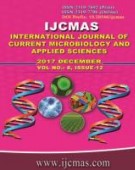


 National Academy of Agricultural Sciences (NAAS)
National Academy of Agricultural Sciences (NAAS)

|
PRINT ISSN : 2319-7692
Online ISSN : 2319-7706 Issues : 12 per year Publisher : Excellent Publishers Email : editorijcmas@gmail.com / submit@ijcmas.com Editor-in-chief: Dr.M.Prakash Index Copernicus ICV 2018: 95.39 NAAS RATING 2020: 5.38 |
The present study was conducted in Doda district of Jammu and Kashmir with the objectives to study the correlation analysis of socio-personal profile of dairy farmers with knowledge and adoption of improved animal husbandry practices in Doda district. Four blocks were randomly selected using simple lottery method. The selected blocks were Kastigarh, Bhagwah, Marmat and Ghat. After preparing a comprehensive list of villages of the selected blocks, two villages were selected randomly from each of the four selected blocks. Thereafter, fifteen respondents were selected randomly from each village. Thus a total 120 respondents were selected in all as the sample. Data was collected through well structured, personal interview from the respondents either at their farm or home after proper testing of schedule and using appropriate scales. Data was then tabulated, analyzed and inferences were drawn in the light of set objectives after application of proper statistics, using various computer softwares. The study revealed young respondents have significantly higher knowledge (55.98%) and adoption (60.48%) than the respondents in old age. Significant negative association was observed between age and knowledge level, with correlation coefficient being -0.217. The statistical analysis of data revealed respondents with higher education status, more diversified occupational activity, extension contact and economical motivation have significantly higher knowledge and adoption level regarding improved scientific animal husbandry practices than the respondents scoring the low in same variables. Herd size does not have significant effect on their knowledge and adoption level of respondents regarding improved scientific animal husbandry practices. Social participation mass media exposure and risk orientation of the respondents varied with the varying levels of knowledge and adoption.
 |
 |
 |
 |
 |